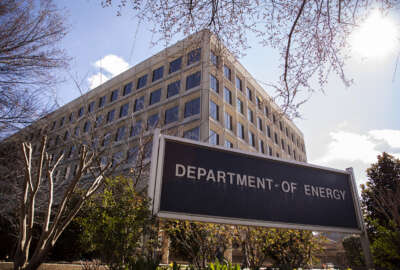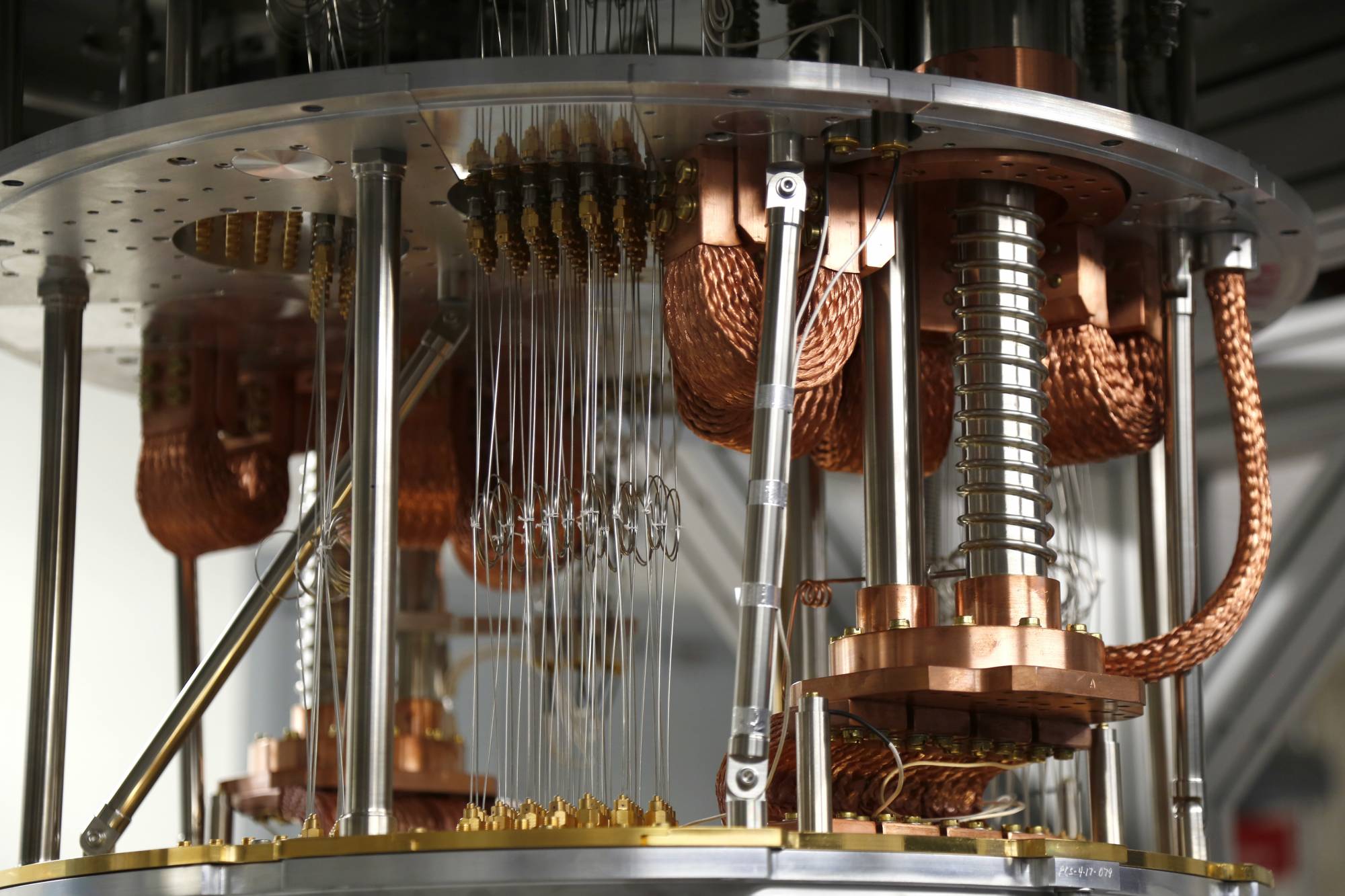Energy Dept joins industry partners in space for quantum technology
An Energy Department project called the Quantum and Space Collaboration has drawn in industry participants. DOE aims to harness cutting-edge quantum technology.
An Energy Department project called the Quantum and Space Collaboration, has drawn in several industry participants. DOE, in its own words, said the collaborative aims to harness cutting-edge quantum technologies for pivotal advancements. In search of the translation, Federal Drive Host Tom Temin talked with Rima Oueid, the Senior Commercialization Executive in the Office of Technology Transitions and with Garland Garris, the Quantum Lead at Accenture Federal Services.
Interview Transcript:
Tom Temin All right, Ms. Oueid tell us what is actually going on here. This is not quantum computing per se, but quantum technologies in a larger sense.
Rima Oueid It includes quantum computing. So there’s a cohort of us in federal service that realize a lot of us are trying to do the same thing where were doing it separately. And we know that quantum technologies behave differently in space. And also there are use cases that benefit various agencies. If we had quantum technologies in space, so that includes quantum computing, quantum sensing which provides imaging position navigation and timing, and then also quantum secure communications. And so we do a lot of communications through space already. But it is not quantum secure. And so this is an opportunity for us to be able to leverage each other’s resources and create a Manhattan like urgency around innovation in quantum. Computing in space is really important, particularly in the sector.
Tom Temin Quantum computing doesn’t really exist in any production sense, though, does it?
Rima Oueid So what’s interesting is we know that we need to be ahead on quantum and computing in particular. We know that quantum mechanics behaves differently in low gravity settings. And so what we may not be able to accomplish here on Earth, we may be able to accomplish in space.
Tom Temin It’s cold enough up there.
Rima Oueid It’s cold enough. But also the actual mechanics of the crystals that we want to produce, not just even for quantum computing, but even for semiconductors, are better produced in low gravity settings with fewer defects. So we could manufacture in space and get different outcomes. We can also apply things in space and get different outcomes. And our algorithms might behave differently in space as well if they’re running on a quantum computer. But there are some near-term applications or near-term quantum computers that we can use today. What we’re lacking are the algorithms. And actually, Google just launched a prize competition around this to find those use cases, which I think is probably been partially inspired by some of the work that we’ve been doing, because we’ve identified over 200 use cases just in the energy sector. But again, the algorithms are missing and that’s what we need to work on.
Tom Temin All right. And Mr. Garris, Accenture Federal Services, you’re a major participant in this quantum project. What do you bring to it.
Garland Garris So we’re working in a number of different areas, primarily focused on helping agencies comply with policy and legislative mandates right now. And that’s focused on quantum security and protecting agencies from the threat that quantum computers will someday be able to crack cryptography they use. And there’s a few policies that are directly relevant to that in 2302. And then what was House Bill 7535 became the Quantum Computing Cybersecurity Preparedness Act. And it laid out some specific requirements for agencies for, first, determining how they use cryptography now, and then coming up with a transition strategy for this generational change of technology, which doesn’t happen that often. So this is going to be a multi-year effort. So we’re helping agencies there. We’re also working in areas of quantum information science within certain parts of the DoD. They’re focused on looking at R&D, combining quantum computing and exploring the intersection of machine learning and artificial intelligence. And all these are very emergent areas which we’re helping the government explore. And then also in the context of communications, the US government, and I hate to put it this way, but we’re a little bit behind in the context of global spend in quantum research. And if you would look at how we compare, say, to China, the U.S. government and the public sector are spending a little less than 2 billion a year, China’s spending about 15. And they have a significant R&D effort with quantum key distribution with their satellite network. And that’s something we’re looking into as well.
Tom Temin The things that come to mind are one on the encryption side, the NIST at the Commerce Department has come up with proposals or drafts, I guess, of quantum resistant encryption algorithms. And we’re talking about space. So our NIST and NASA part of this whole thing.
Rima Oueid So NASA is involved, yes. But what NIST is working on is the post-quantum cryptography. But we’re looking beyond just the post-quantum cryptography. We’re looking at things like entanglement for secure communications. So it’s different protocols and using sensors as well. So quantum sensors.
Tom Temin What does a quantum sensor.
Rima Oueid Well, there’s lots of different types of quantum sensors, but they are able to detect anomalies and also capture images at much more precise levels and be able to see through the ground from space, see under the surface to be able to identify from a Department of Energy standpoint, things like geothermal water, where we didn’t know water may exist, caverns where we can store carbon, do oil and gas exploration in more precise ways so that we disrupt the environment less, and then also to be able to see in the ocean, which is also important for offshore wind siting. And then obviously, you can imagine what the DoD use cases would be in that area. So quantum sensing is actually kind of the unsung hero in a lot of this, I think. It’s a technology that has been around for 20, 30 years. We’ve been using quantum sensors in MRI machines. We use them in atomic clocks, GPS use it, but because of the distance, GPS is easily spoofed, jammed and hacked. And energy infrastructure depends on GPS, cars, automated vehicles. All these things that we plan for utilizing in the future become potential targets for malicious actors if they’re not secure. Imagine a malicious actor hijacking GPS one brand of vehicle. I’m not going to name any because I don’t want to upset anyone, but just imagine the implication of those vehicles being hacked. And they don’t have to be EVs. We use them today in internal combustion engines.
Tom Temin So a quantum sensor then is something that is composed of elements that are not binary, that is one state or the other, but they have many intermediate states. That’s my basic rudimentary understanding of quantum.
Garland Garris So that’s combining a couple of different things. But quantum sensors will enable you to have precise measurements that greatly exceed what we can do now with GPS alone. So down to a millimeter, for example. And if you’re a Department of Defense and you have a UAV, you can have 100% confidence that it is not going to be jammed and it’s going to work 100% of the time, instead of using triangulation with cell phone services, you’re going to have pinpoint accuracy where a device is. And as Rima indicated, it can be used to detect things that you can’t use with other measurement tools. As far as the other topic, I think that’s really getting into quantum computing and how quantum computers work, which are quite different than classical systems.
Tom Temin This is not a physics class anyway, and I don’t understand the physics and nobody probably listening would. But let’s get to the practical side of this. You’re going to have to put things in space to do things. Describe for us what an experiment might look like. And what would the outcome you would hope for would be? And what would go up there? And by what means would it get there?
Rima Oueid So we’re starting off with some of the easier technologies, things that are already commercially available. So we know that quantum entanglement for secure communications already available. And we are looking to demonstrate the ability to be able to use that in communications from satellite to ground. And we can start by putting something up on the ISS, the space station. There’s already a Bose-Einstein condensate. So it’s a quantum sensor. So not part of communications, but that’s already been put in space. And that’s where we realized that these devices behave differently in a space setting. And we actually can create different types of connections and different abilities for sensing things in space.
Tom Temin And as entanglement, you use that word a couple of times, is that the same as scrambling a signal or encrypting it in some way.
Rima Oueid It’s more about the secure communication. It’s a connection. So if it’s intercepted, if somebody tries to eavesdrop, that connection gets dropped. It’s unhackable.
Tom Temin The observation of it is what stops it. There’s a principle of that, and I don’t know the name of it anymore. So it sounds like DoD would be part of this also.
Rima Oueid Absolutely.
Garland Garris Yeah. There’s a lot of, I guess, joint efforts between the federal civilian executive side and then DoD labs, DARPA, AFRL, which overlap to a certain extent. And entanglement itself, that is a rabbit hole. You can go down. There’s a lot we don’t understand. And in fact, the Nobel Prize was awarded to three gentlemen last year.
Tom Temin I think you mean it will go down a wormhole, not a rabbit hole.
Garland Garris I guess that’s a better analogy. But they were awarded the prize for proving that it couldn’t be explained. Rather that hidden variables, which was the traditional thinking, explained how entanglement work. They proved that’s not the case. So in the hidden variable is easy enough to understand. I’ll give you just a really quick analogy. If you have two golf balls, one’s black, one’s white. Your best friend is Elon Musk, and you convince him to take one of these to Mars, they’re in a box, you don’t know which is which. And then after that rocket arrives on Mars, and then Rima opens up her boxes just, oh, I’ve got the white one. So therefore, you know the black ones on Mars. And that would seem to be faster than light communication, which it isn’t. It’s basically because you have one you know where the other is. But that was determined before the rocket even left. So they were given the Nobel Prize for proving that was not what was going on with quantum. And we still don’t understand it. But just like with other areas in quantum physics, we don’t have to fully understand why it works the way it does to be able to use how it functions. So we understand enough to use our understanding of quantum physics to create quantum computers or to use quantum entanglement or quantum teleportation for communications.
Tom Temin Backing out of the wormhole for a minute, just tell us the relationship between the Energy Department and your corporate partners. Is it a contract relationship? Is it a grant relationship? Is a [Cooperative Research and Development Agreement (CRADA)]? What have you got going?
Rima Oueid So some of these partners oftentimes already have contracts with the government. So they either have the contract with DoD or they have it with NASA or they have it with us. And CRADA’s are actually a great way to work with the Department of Energy because we have so many labs, we have 17 national labs. And so we prefer that companies have CRADA’s with the labs themselves because we work through the labs. So there’s many different mechanisms for being able to partner. But the gist is that a lot of these partners are coming to the table because they already are working with the federal government, and this is a way for us to be able to triangulate the work that’s being done at a much more detailed level to understand who knows what, who understands what. And it’s an opportunity for us to do information sharing. So we’re not being duplicative. And we’re also doing some brainstorming to understand what is feasible. Because as we’ve kind of touched on today, no one really totally understands quantum mechanics. Anyone who says they do.
Garland Garris Doesn’t understand quantum.
Rima Oueid And this is something Richard Feynman said. So what we need to do is start asking questions and tinkering, because this is going to be an area where we’re going to learn by doing. Because it’s the things that we don’t understand. If we try to put ourselves in a box, we’re going to remain in that box.
Tom Temin So what’s the first thing that’s going to happen under the quantum in space collaboration?
Rima Oueid Well, the first thing is we’re all understanding what everyone is doing and what everyone understands. And then the next step is we want to start putting devices in space and doing the space to ground communications. Something that we’ve learned we’re working through communications via fiber. We may find it easier to do quantum communications through free space. And so it may be that space is a better medium for quantum communications or space to ground. Nevertheless, there’s a lot of information that we want to capture in space that would ultimately have to be transferred back down to the ground. And then a lot of information gets lost during that data submission process. And then there’s a delay in processing that information that creates lower fidelity information that you end up in delayed information. And as you can imagine, DoD and timing is everything for them. And accuracy is very critical for them. And so this is an opportunity for us to be able to capture information in space, process information in space, and then submit it in a secure way.
Tom Temin Right. So the processing would be up there and not subject to the problems of back and forth.
Rima Oueid Potentially. That’s what we’re evaluating.
Tom Temin And just a final question, because this is getting deep or high or wide, I’m not sure which maybe all the above which is quantum. But what is the way when you communicate normally with space, there’s radiation coming down that excites an antenna right on the Earth. What happens in quantum communications? You still have to have some kind of a carrier signal or a carrier energy source to take the the what to wear.
Garland Garris One would be focused on quantum entanglement and being able to change one particle in one end and immediately change the other. We haven’t completely cracked the math on that. That’s still an area of exploration. And there’s some impossibilities with what we know right now, which we have to work through. Quantum photonics is usually where a lot of the current communication focus is with quantum communication. And of course that means using light to communicate.
Tom Temin Lasers.
Garland Garris Yes. So, a lot of different technologies come into bear there. But basically using photonics to communicate in a way that if it was intercepted, it would be immediately known or you could basically create a communications protocol such that it would be 100% secure, it would be impossible to actually intercept.
Tom Temin So China couldn’t fly a mirror there and divert the communication to them.
Garland Garris Correct. So the potential for just augmenting or increasing security to the point that we don’t have to worry about intercepts anymore. That’s the potential there. So obviously huge interest on the part of the defense side. And then also speed and communication. And there’s a lot of other benefits. But so much to explore. So within this collaborative, we are talking with some of the brightest minds that are working in these areas that are part of this collaborative. And then figuring it all from a pragmatic sense, where should we focus our efforts? Here’s where the government is focused in quantum teleportation. How does quantum computing stack up? Which one should we hit first? So that’s a lot of the conversations we’re having right now. And then a lot of us in turn communicate with, I should say, and the government any way communicate with policymakers. And that influences how these efforts are funded. And then to communicate the immediacy and the urgency and the fact that we have to start running faster in this or we will be left behind.
Copyright © 2025 Federal News Network. All rights reserved. This website is not intended for users located within the European Economic Area.
Tom Temin is host of the Federal Drive and has been providing insight on federal technology and management issues for more than 30 years.
Follow @tteminWFED






